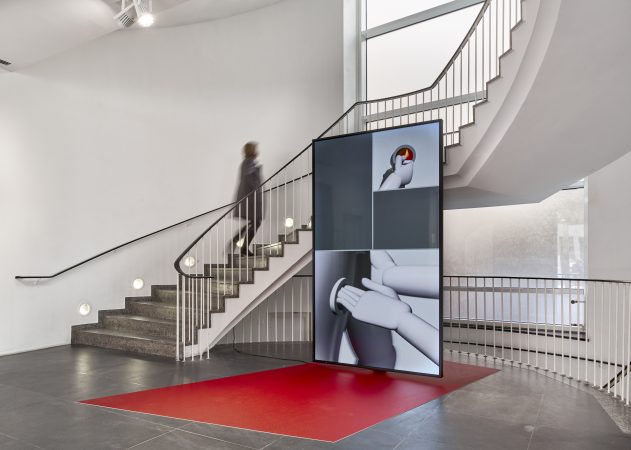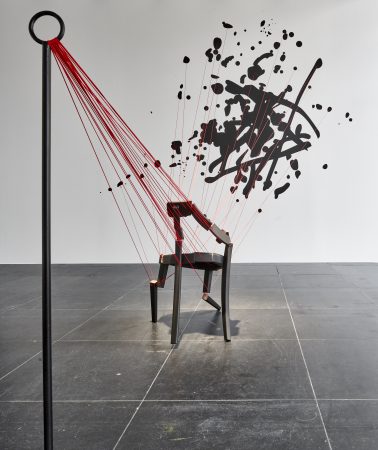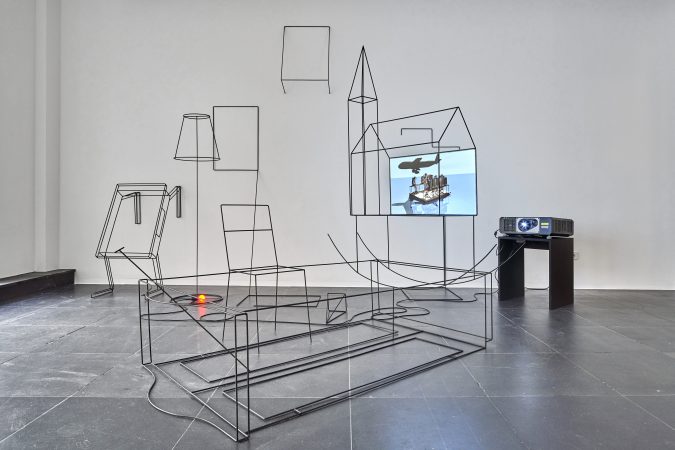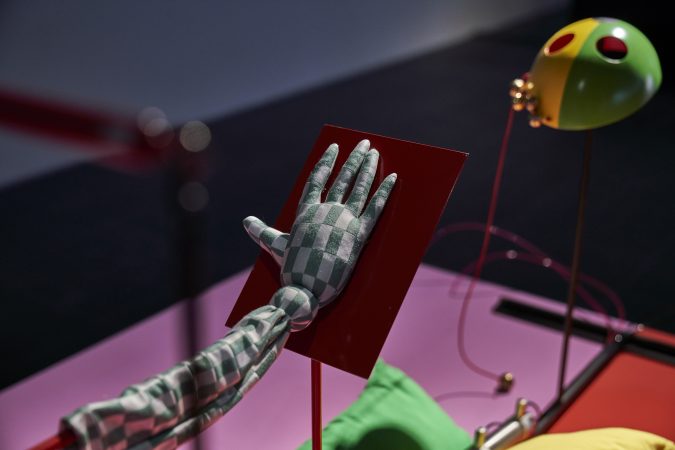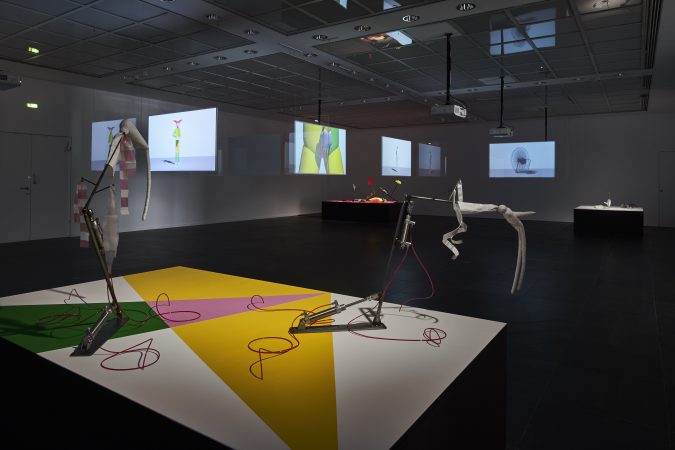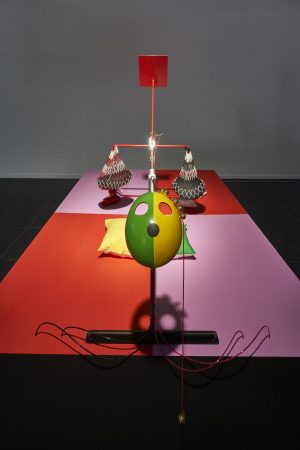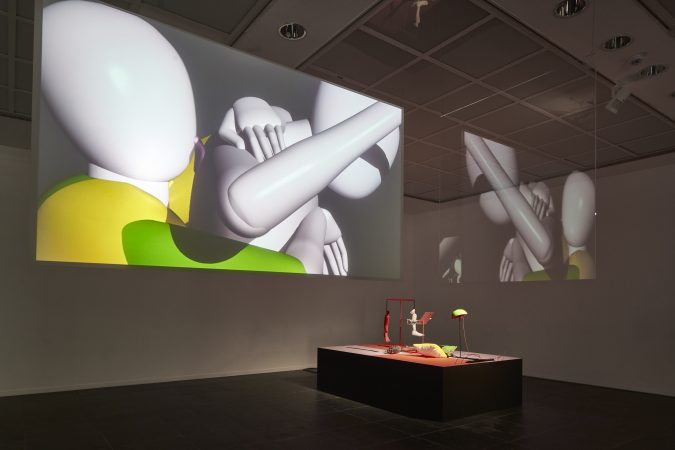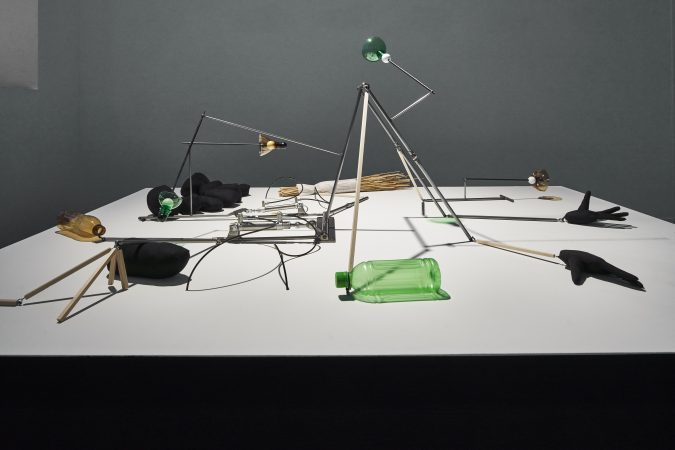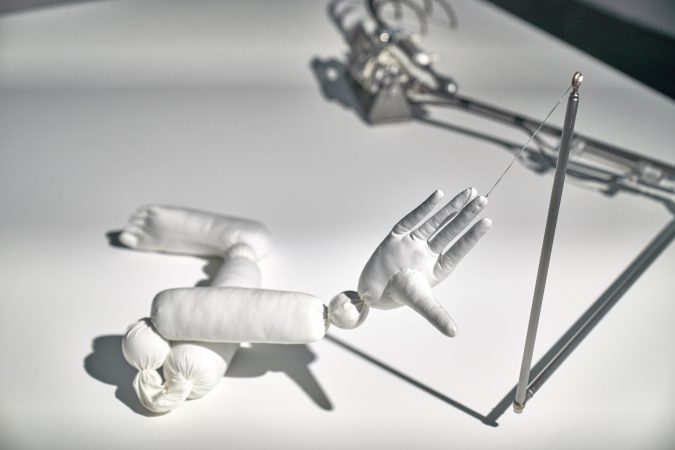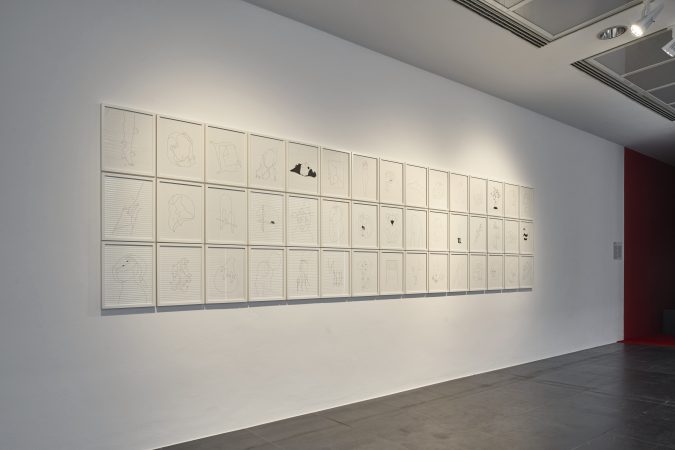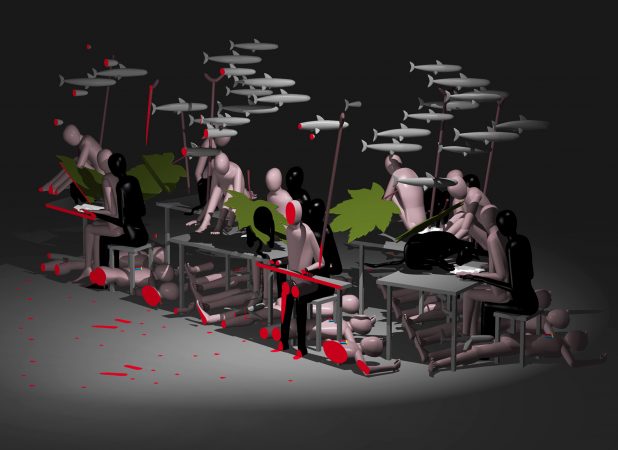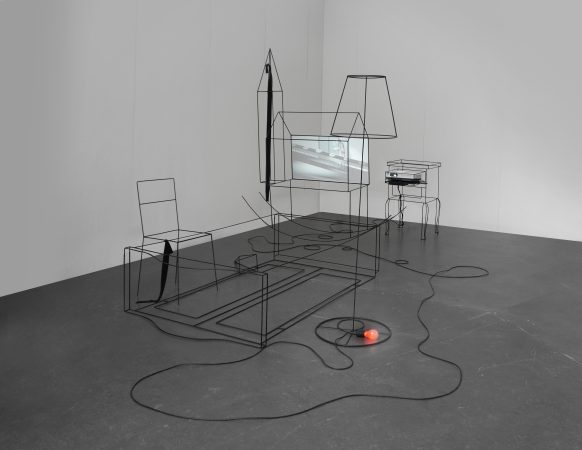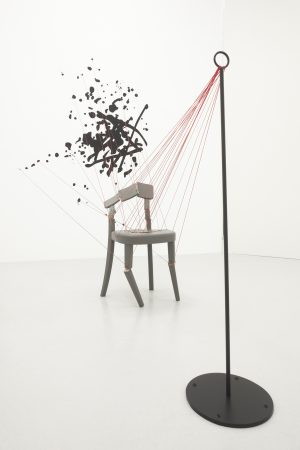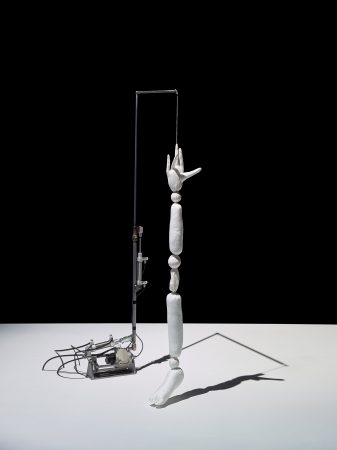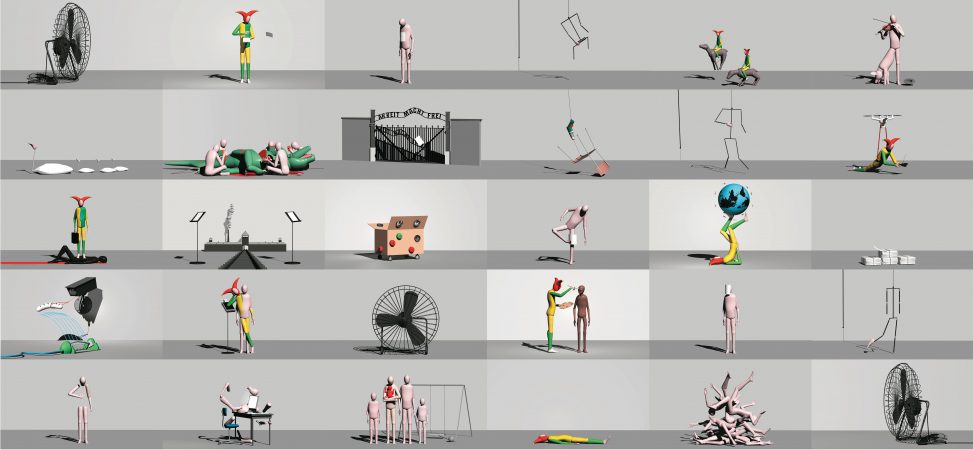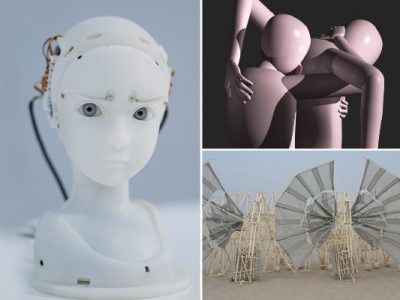Yves Netzhammer
Empathic Systems
14.06.2019 — 08.09.2019
Kindly supported by: Pro Helvetia
The Frankfurter Kunstverein has invited Yves Netzhammer, Theo Jansen, and Takayuki Todo to present a selection of their works in solo shows, under the shared thematic title “Empathic Systems.”
The Frankfurter Kunstverein presents a survey of works by Swiss artist Yves Netzhammer from the last ten years. Netzhammer’s artistic oeuvre represents the examination of the central issues of being human in the digital age.
By the early 2000s, Netzhammer had already placed key questions at the center of his artistic research that sought the breaking points people encounter in dealing with the world today. The exhibition will showcase a specific selection of significant works from Netzhammer’s formal repertoire, with a focus on questions concerning the nature of human emotions and existential experiences.
Netzhammer’s work is not interested in realistic representations of the world, but rather seeks to analyze the essence of human action on the basis of image studies. The protagonists of Netzhammer’s works are reduced to the essential features of the human figure and are reminiscent of mannequins and anatomical models. The reduced visual worlds initially seem like experimental arrangements. He transforms his characters into the immaterial of digitally generated drawings. His figures forgo individual personality traits and thus, as archetypal human figures, represent the essence of existence.
The works dispense with words and text, they tell stories in scenes that skillfully trace an arc by stringing together fragments over the duration of the animations. Netzhammer translates emotional landscapes into a visual language that explores the fragile dividing line between the inner and outer world. His figures act in recurring sequences that create meaning in the succession of physical repetitions. Netzhammer deliberately reduces the visual repertoire to the essential: he works in primary colors with stylized forms, implied empty spaces, and processes in which the temporal dimension remains vague.
The artist deliberately refrains from giving his figures any individual traits, so that it is never about the portrait of a person, but rather general human characteristics. The figures have no faces, no eyes, and no facial expressions, they do not speak. It is not their expressions to which the observer could attribute emotion; it is their actions and gesticular physical formulations. Performed physically, these become precise depictions of indications of inner states, producing an immediate recognition of intentions and emotional landscapes.
The power of Netzhammer’s works arises from the transfer of meaning. He translates studies and observations of the real into new emotional contexts, rendered in image compositions. He creates his own individual visual language through repetitive actions, elements, and fragments of meaning that his characters act out. This results in a meta-semantics of physical expression. The interpretation of physical movement is a prototype of interpersonal communication that constitutes the human essence with an archaic immediacy. Netzhammer’s figures build on this corporeality. He animates them on the computer, synthetically recreates actions and movements, studies and recognizes sequences of motor-based expression, and uses them to construct his humanoids.
Netzhammer’s works address the viewer on this physical level. The empathic relationship with the animated characters is based on a reflection of physical sensation. This results in the viewer’s recognition of the figures’ gestures. We associate emotions with these gestures, despite their being formulated differently, and their ambivalence.
The body of the figures is a recurrent material that plays a central role in Netzhammer’s work. The boundary between interior and exterior is vulnerable and open. The smooth digital surfaces of the bodies are opened up. They produce an exchange of colors, things that create metaphorical associations. The images traverse a fine border where brutality and gentleness permeate and transpose each other in the details of the work.
Netzhammer’s animated films are always amplified by an acoustic level. Sound artist Bernd Schurer is Netzhammer’s kindred counterpart, who, with minimalistic soundscapes, manages to anchor the pictures for the viewer on an emotional level. In an analogy to Netzhammer’s visual worlds, Schurer also alternates between gentleness and cutting sounds, silence and acoustic sequences, which enhance the atmosphere of the visual worlds, sometimes melodically, sometimes as noise.
Netzhammer’s works address the viewer’s capacity for empathy. Empathy is a feeling of the temporary dissolution of the boundary between the self and others. A state of empathizing with the inner worlds of a being that is not oneself, and whose existential condition can momentarily become one’s own. In the act of silent observation, this empathic feeling can achieve a changing self-perception through emotional compassion, a capacity for resonance with the other person. Netzhammer forms and merges one image into the next, creating new autonomous worlds and making new contexts legible. He draws general and universal metaphors of existential perception. Anyone who engages with them can enter into this new digital and symbolic reality, and recognize or find something lying dormant in the secrecy of their own existence that tells of the fragility of human existence.
The exhibition brings together a selection of Netzhammer’s digitally animated films from various creative periods. Among them is one of his main works, “Die Subjektivierung der Wiederholung“ (The Subjectivisation of Repetition). It was part of the comprehensive installation that he designed for the Swiss Pavilion at the 2007 Venice Biennale. All of Netzhammer’s fundamental artistic features that characterize his work can be found in the 42-minute piece: interlocking motifs that repeat themselves, change, and reappear in fragments in order to merge and form new constellations of meaning, and visually render diffuse emotions in the search for new dimensions of sensibility.
His latest five-channel work “Biografische Versprecher” (Biographical Slips) transfers the digital imagery of computer animations into a spatial expansion. The projected images are reflected in numerous transparent surfaces and create a visual echo of their own reflections. Netzhammer translates elements of the humanoid figures and their actions into the material world of kinetic sculptures that operate in the space. Assemblages of objects, reminiscent of puppets’ body parts, arms and legs, are moved, pulled, and pushed by mechanical constructions on the surfaces of their sculptural bases. Compressors control the drive. This results in scraping noises, jerky movements that wear out the delicate objects over time and slowly destroy them. These are unique pieces that the artist has revived up for the exhibition at the Frankfurter Kunstverein and reworked for this specific location.
Another important focus of the exhibition is the presentation of Netzhammer’s comprehensive graphic oeuvre. Netzhammer draws exclusively on the computer. For the Frankfurter Kunstverein, the artist has chosen a selection of outline drawings that clearly demonstrate the principle of reduction and pictorial thinking in a concentrated manner. Starting from the two-dimensional drawings, the selection of works shows Netzhammer’s expansion into the three-dimensionality of the graphic line. Netzhammer transposes this onto the “Vororte der Körper” (Peripheries of Bodies) in the materiality of black metal wires. As outlines, these wires carve into the emptiness of the space. Like a trace, they point to absence in space. Netzhammer extends this step from drawing to object in a third group of works in which materiality now asserts itself in the space: “Adressen unmöglicher Orte“ (Adresses of Impossible Places). A chair is suspended in the moment of breaking, temporally fixed in the movement of falling, connected to the wall by red threads. These are like the red lines of a perspective drop shadow. Their ends meet like points on the depiction of a controlled color explosion.
About the exhibition “Empathic Systems”
The Frankfurter Kunstverein has invited Yves Netzhammer, Theo Jansen, and Takayuki Todo to present a selection of their works in solo shows, under the shared thematic title “Empathic Systems.”
The works of the three artists use varying aesthetics and result from completely different artistic processes. Nonetheless, all the works share a corporeal appearance despite being synthetically made. They are capable of touching the viewer solely through the form of their physical activity in space, beyond any recognizable linguistic conceptualization.
The exhibition revolves around the complex emotional relationship between humans and technology. Communication processes no longer only happen from human to human, but between humans and technology. Digital technologies are also increasingly exchanging data solely between each other.
Yves Netzhammer’s artistic oeuvre offers an examination of the central issues of being human in the digital age. His humanoid figures are reminiscent of anatomical puppets, devoid of any individual traits or facial expressions. Through them, Netzhammer formulates metaphors that translate the spectrum of human emotions into images. In a sequence of gestures and moments, he creates moods that the viewer knows how to decode, should they be willing to empathize and feel on behalf of the figures. Netzhammer’s figures define themselves through interaction with their environment. The reduced arrangements result in dense scenes where individual interaction processes take place that act as syntheses of human action and feeling. He extracts the essence of human experience and uses digital drawing and programming techniques to create animations that evoke empathetic reactions in the viewer. Netzhammer occupies three floors of the Frankfurter Kunstverein with a selection of his digital animated films, graphic works, and new kinetic installations.
Theo Jansen creates expansive kinetic sculptures and describes them as a new form of non-biological life. He builds the sculptures from synthetic materials such as polyurethane tubes, cable ties, and plastic bottles. The creatures he constructs are then are set in motion by wind, building up kinetic energy to start moving. Via a computer program that Jansen developed, an algorithm calculates the mechanics of the walking apparatus. The supporting skeleton is constructed in precise proportions. This creates flowing, insect-like movements that have an immediate effect on the viewer. The empathic relation to the creatures is not established by their face, anthropomorphic traits, or an expression, but rather their movements in space.
With his work “SEER,” Takayuki Todo explores the emotional effect of eye contact and facial expressions in the interaction between humans and technology. Using 3D printing modules, miniature motors, and facial recognition software, Todo has created an anthropomorphic head that seeks the viewer’s gaze, reciprocates it, and mirrors their facial expression. The minimal movements create an immediate synchronization of the gestures and facial expressions between human and humanoid, as well as an emotional reaction in the viewer. An asymmetry in the interaction emerges. For the viewer, the machine’s behavior seems like an expression of emotions. What the technical body accomplishes is the deconstruction and reproduction of the human gaze and the movements of the face’s surface. Though the viewer projects human intentions onto the machine, they are essentially looking at a reflection of themselves.
All three artists work at the intersection of engineering and computer science with psychology, cognitive science, neuroscience, and ethics. They bring together a variety of technical, artistic, and psychological principles. The works elicit a level of feeling in the human viewer that is not always linguistically graspable, but instead appeals to an empathic sensitivity. In a number of ways, their artificial apparatuses become mirrors viewers encounter and recognize themselves in: sometimes in their doubling, sometimes in their distortion.
Humans and machines differ substantially in the sensory apparatuses they use to perceive and understand the world. Recognizing things begins by grasping them sensorially. Humans experience and understand the world through their body and their sense organs. In doing so they create their interpretation of the world in the form of cognizance. The body is the medium for human being-in-the-world. It acts as the link between humans and the world, or between subject and object. It belongs to the ego and the world at the same time, it is subject and object in one. Technology does not have this corporeality.
Today’s state-of-the-art computer science has produced programs and algorithms that generate machine-specific knowledge through data sets and associated information. The ways that humans and machines generate knowledge and their consequent actions are still different. But the questions remains whether this gap narrow in the future.
Although there is neither a unified theory of emotions in the natural and behavioral sciences nor a definition that is accepted across the disciplines, interdisciplinary research projects are investigating different methods of increasing the human emotional response to digital agents under the heading of “Affective Computing.” Numerous industrial sectors have a great interest in recognizing emotional systems in order to use them for the development of machine learning and artificial intelligence. Functions should sound and look “more human,” thus minimizing the difference between human feeling towards technology as opposed to other humans.
For the most part, human beings can only recognize emotional signals and signs on the basis of physical characteristics. As such researchers are working to ensure that speech interfaces, talking robots, or humanoid nursing assistants, for example, are designed accordingly. Interfaces are being developed that implement knowledge about the meaning of emotional states and moods.
Research into emotions is thus gaining an increasingly central role in the research and development of artificial intelligence. Technologies are being used that examine users’ moods and their emotional reactions to content. Systematized knowledge about feelings, emotions, sensations, as well as moods, perspectives, and intentions is already being implemented in a targeted manner. So-called “online sentiment analysis” is being conducted, namely algorithmic tests that classify all content according to whether it was created with a subliminal positive or negative sentiment. Each author’s content and attitudes are evaluated. Political entities and commercial enterprises benefit from in-depth knowledge about the emotional responses of an individual, who is always also a user, consumer, patient, citizen, and thus part of an overall social system. Digital assistants and systems are undergoing further development to the point their speech recognition not only understands what a human is saying, but also the emotional state they are in as they do so.
The question concerning the meaning of emotions and the gaze of the other is one of the eternal human issues that have played a central role in all of cultural history. The exhibitions at the Frankfurter Kunstverein seek to show and reflect the connection between contemporary art production and current social phenomena. The perspectives of the interdisciplinary research field of Affective Computing will have an impact on a wide-ranging social and political scale.
The exhibitions devoted to Yves Netzhammer, Theo Jansen, and Takayuki Todo offer a concentrated view of each of their artistic worlds and aesthetic formulations. The exhibitions function through spatial experiences in which viewers encounter the works physically and sensually.
Netzhammer’s works beguile visitors with their intense visual and acoustic power. Todo’s SEER requires the visitor to actively interact with the robot, stepping directly in front of it to establish an emotional connection through eye contact. Theo Jansen’s kinetic sculptures are animal creatures that visitors can set in motion with their own physical strength in a sandy landscape.
Art has the ability to make people pause, perhaps halt time for a moment, forget for a moment, and to marvel. In amazement there lies an existential force, a yearning for deeper knowledge, for an understanding of the inner workings, for what “it” is and how to grasp it. The artistic view of the world is restless, questioning, searching, and striving for forms of representability. It employs for metaphor in the search for knowledge. Those who follow this view can succeed in experiencing something new through feeling empathy with others and re-experiencing themselves in this realm. In this encounter, art can become a transformative force.
Curator: Franziska Nori

